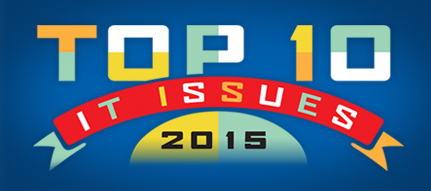You have /5 articles left.
Sign up for a free account or log in.

Educause
The pace of change in technology is widening the gap between early adopter institutions and those struggling to keep up, Educause's report on the top IT issues and strategies for 2015 shows. Some IT leaders say it's time for colleges and universities to accept that they won't be able to do everything on their own.
Educause’s researchers said higher education is approaching an “inflection point for change,” and that the development fueled by a combination of technological advances and outside scrutiny. At the same time as students, parents, politicians and donors are growing concerned with the cost and quality of a college education, the researchers said, colleges and universities are using technology in classrooms and administrative offices to try to address those issues.
“In all these different ways, I think IT offices are ready, technology is ready and higher education as an institution is ready to change in ways that it really has never been before,” said Susan Grajek, vice president of data, research and analytics at Educause. “I think that we have reached a point where change is not only something to think about and talk about, but change is something to do.”
Educause’s annual list of Top 10 IT Issues, decided by a panel of administrators, staffers and faculty members and then ranked by the Educause members, serves as an indicator of the priorities and changes IT leaders expect to see in the new year. The report, released this morning, suggests college and university IT offices need to play an active role in promoting that change.
“The relationship between IT and the institution really needs to change if we’re going to use technology to address the fundamental issues that need to be addressed in higher education,” Grajek said. “Higher education leaders need to not just let their IT leaders do their own thing, help them fund some initiatives, but they really have to understand the potential of IT."
Apart from inserting themselves into conversations about institutional strategies and priorities, IT officers already have a busy 2015 ahead of them. Their list of top 10 issues includes figuring out how to let students and faculty bring their own devices to campus while keeping their data secure, helping faculty use technology in the classroom and -- most importantly -- hiring, retaining and training the staffers who will work on those and other tasks (see box).
Top 10 IT Issues of 2015
- Hiring, retaining and training staff
- Optimizing the use of technology in teaching and learning
- Developing flexible IT funding models
- Improving student outcomes with technology
- Demonstrating the business value of IT
- Increasing the IT office's capacity for managing change
- Providing user support for different needs
- Developing security policies
- Developing an enterprise IT architecture
- Balancing agility, openness and security
The results resemble those seen in the most recent edition of the Campus Computing Project’s annual survey -- coincidentally released during the same conference where Educause previewed its list. In both cases, survey respondents picked hiring staffers and using technology in education as their top two priorities.
Colleges and universities are searching for new talent in part to answer demands for new technologies while simultaneously offering core services such as user support, which Grajek described as the “new normal” for higher education IT offices. Many institutions, however, are already falling behind, she said.
Separate from IT issues, Educause also asked its members to rank the technologies they plan to introduce to their campuses in 2015. Out of 107 options, only four technologies are in place at more than 30 percent of participating institutions. The top 10 "strategic technologies" for planned introduction are this year dominated by technologies directly or indirectly related to mobile devices, such as app development, data protection and wireless networking -- but only between one-third to half of the surveyed institutions said they believe the technologies will be in place by the end of the year.
Last year, in comparison, four of the top 10 technologies had to do with analytics, but although two of them -- course-level and degree-advising learning analytics -- have dropped off the list, that doesn’t mean institutions are less interested in analytics in 2015, Grajek said.
“What we’re finding is that institutions are picking up the pace and paying more attention to more technologies,” Grajek said. “Attention isn’t shifting in the amount of effort, it’s shifting in terms of expanding.”
In addition to the items already on their agendas, more than 30 percent of respondents said they are watching how 11 different technologies develop before they decide whether or not to introduce them to their campuses. That list includes adaptive learning and open education resources, but also how the “internet of things” and next-generation learning management systems might benefit colleges and universities.
In other words, IT staffers are watching their to-do lists grow longer by the semester. Grajek said it will take “considered attention and intentionality in investment from these institutions” to keep up.
Some university chief information officers, such as Armstrong Atlantic State University’s Robert P. Howard, said IT offices should be selective about which technologies to invest in to ensure the money is spent on initiatives that address specific campus needs.
“There will always be a great list of ‘new things,’ but I think it is important to know your campus to know the adoption patterns and how you can pilot, scale or discard technology,” Howard said in an email. “How will this add value to the campus? Does it improve enrollment, external funding or creation of research and scholarship?”
Yet for some institutions, the solution may be to realize that they can’t offer both core services and every new technology on their own. Grajek said more colleges and universities may pursue a shared services model, where staffers are consolidated into one office that serves the entire institution. Such plans have faced opposition at some of the institutions that have attempted to move to that model, though others have reported saving millions of dollars.
The future may also hold more specialization for college IT offices, Grajek said, where institutions create centers for excellence to offer services to other colleges and universities, while relying on other institutions and vendors to offer the services they don’t provide themselves.
“I think that this notion of going it alone and creating your own IT solutions is one that is something people will have to put behind them,” Grajek said. “A lot of it is carefully understanding the new roles that need to come up and retraining existing staff. That’s not easy, but it’s certainly the most humane path.”
Other IT officers were more optimistic about those challenges. Wayne A. Brown, founder of CHECS, the Center for Higher Education Chief Information Officer Studies, said the many priorities listed in the Educause report show the skills required by IT leaders.
“The CIO has grown from a hardware- or software-focused person in the basement of a building to a higher education executive who is expected to not only understand technology and be able to lead a large, complex and expensive department, but who also should be a first rate communicator who understands the business (and higher education) and can build relationships while implementing all of these projects,” Brown said in an email. “What a great job!”




